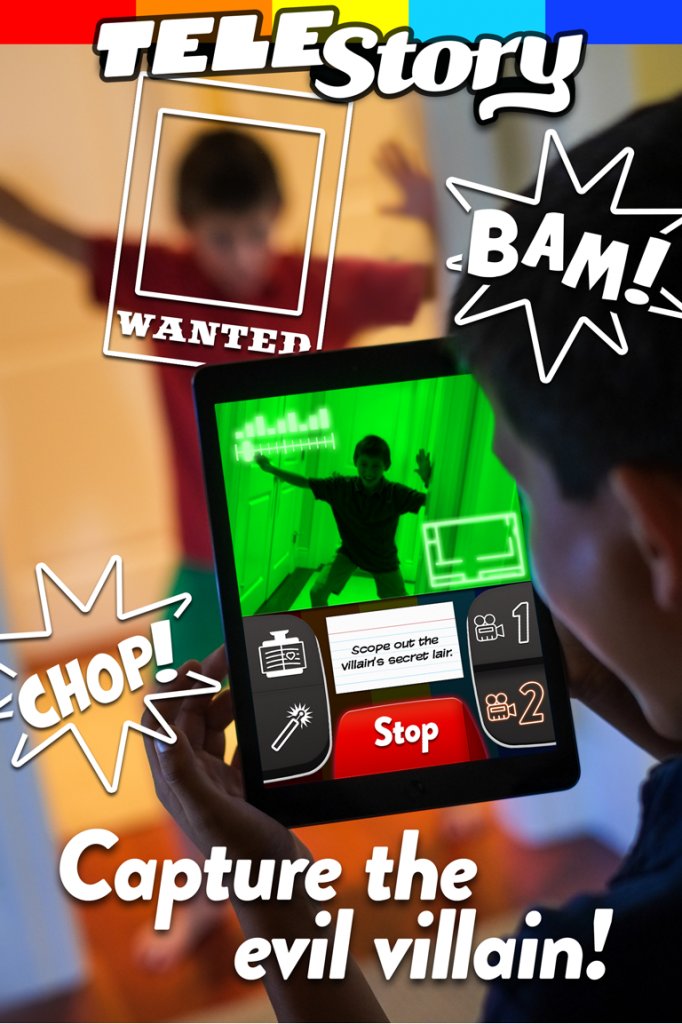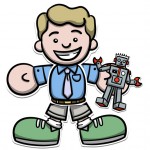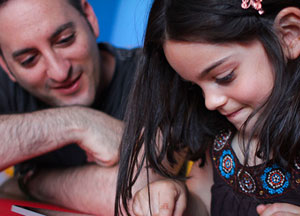What if we could reimagine the iPad as an augmented reality camera for kids to act out their own stories – a costume box for the 21st century?
You’ve all heard the stats. One in three American kids are obese or overweight and will suffer from diabetes at some point in their lives[1]. After diet and exercise, two of the biggest culprits in this epidemic are TV and gaming—the average 8-18 year-old spends 7.5 hours every day on entertainment media[2]. American kids born after 2005 watch 35 hours of television each week[3] and spend 7 hours a week gaming on phones and tablets alone[4]. Meanwhile, only 1/3 of high-school students get the recommended amount of daily exercise[5]. The correlation isn’t coincidental.
Beyond health, there are some pretty scary social effects too – outdoor play isn’t just good exercise, it’s a great place for kids to practice their “21st century skills”—creating, constructing, and collaborating in the sandbox, the backyard, and the ball-field. Whether it’s assigning rules for kickball or roles in “Cops and Robbers”, communication skills developed through play are critical to child development… though the jury’s still out on mid-frag mom-jokes from frtblster2005.
At Launchpad Toys, we build “digital toys” like Toontastic that empower kids to create and share stories online. As mobile app developers, we’re proud to see kids so engaged with our tools, but also concerned that it might be at the exclusion of exercise and time outdoors. With this in mind, we set out a couple years ago to “put the mobile back in mobile gaming” – to create an app that encourages kids to turn off the TV, get off the couch, and run around outside. Instead of watching TV, what if kids could create their own TV shows in the backyard?
 Today, we’re proud to announce TeleStory – the second app in our “Creative Suite for Kids” that enables kids to film and broadcast their own TV shows using digital costumes and real-time augmented reality settings and effects. Imagine all the role-play games you acted out as a kid, but captured on film to share with family and friends around the world. Our goal for the app was to design a creative lens for kids to reimagine, remix, and explore the world around them. We learned a lot in R&D and, with the hope of inspiring other developers to embrace “digital play,” we thought we’d share a few things we figured out along the way.
Today, we’re proud to announce TeleStory – the second app in our “Creative Suite for Kids” that enables kids to film and broadcast their own TV shows using digital costumes and real-time augmented reality settings and effects. Imagine all the role-play games you acted out as a kid, but captured on film to share with family and friends around the world. Our goal for the app was to design a creative lens for kids to reimagine, remix, and explore the world around them. We learned a lot in R&D and, with the hope of inspiring other developers to embrace “digital play,” we thought we’d share a few things we figured out along the way.
1. Creating > Editing
iMovie, Photoshop, Flash, Action Movie FX… there are dozens of great tools out there for creating video and motion graphics, but they’re all based on age-old ideas of editing and compositing – you film a video and then sit for hours cutting it up and overlaying effects to make your story more engaging.
With TeleStory, we quickly learned that this was a non-starter. Kids between 8-12 years old didn’t want to sit and edit, they wanted to play and create. We didn’t need to add glitz and glamour in post-production to make their stories more interesting – their stories were already amazing—we simply needed to create lenses to spark their imaginations in real-time and capture kids’ stories as they saw them in their heads. Over time we realized that we weren’t building a camera, but a catalyst for improv performance.
2. Building Blocks Aren’t Just for Little Kids
Here at Launchpad Toys, we think of our apps as the toys we always wanted as kids – tools to create cartoons, music, TV shows, and other media that we loved to watch but weren’t “grown-up” enough to make ourselves. The first step is always technical: how to redesign a “professional” creation experience (keyframe animation, video editing) to match how kids actually play and create (puppet theaters, dress-up play). The second step, however, is usually the most challenging: how to make abstract concepts like “story” and “TV show” accessible to creators of all ages.
Being Constructionist minded, our answer is to break these concepts down into LEGO-like building blocks for kids to remix and reassemble as they see fit. In Toontastic, we use the Story Arc as a scaffold—splitting “cartoons” into Characters, Settings, a Setup, Conflict, Climax, and Resolution. TeleStory, however, was more challenging. What makes a TV show? There wasn’t a lot of literature on the matter, so we decided to give kids a simple camera/effects tool and ask them to create one themselves. At first there was a lot of running around and blasting things – not much in terms of cohesive story. In time though, we started to notice patterns in the form of “tropes” – pop-culture clichés like “Alien Overlord hijacks ship for ransom” and “Villain ties damsel to train tracks” – and re-centered the app around these classic scenes and “cue cards” as storytelling prompts. The results were remarkable – just as the Story Arc scaffolded 5-10 year-olds’ creative writing in Toontastic, pop-culture tropes gave our tween creators the building blocks they needed to improvise onscreen in TeleStory.
3. It Takes Two to Tango
We knew from the start that we wanted TeleStory videos to be dynamic and engaging – flipping between various locations and different props as kids told their stories. What we saw with early prototypes, however, was a lot of expository writing or, in the words of Syndrome from The Incredibles, “Monologue-ing”. Kids weren’t acting out their stories as much as they were describing them, which doesn’t make for the most thrilling television. What were we missing?
As always, we went back to the playroom – what is it about dolls, action-figures, and costumes that’s different from what we had created? The answer became clear very quickly: dialogue. What our “toy” was missing … was another toy. Optimus Prime needs Megatron. Barbie needs Ken. It wasn’t enough for us to create a “magic video camera” with props and settings – we needed to enable kids to assume the roles of multiple characters within a story in order to move it forward through dialogue. The next week we introduced face-tracked costumes and Eureka!… TeleStory was born.
So we hope what we’ve learned inspires all you fellow researchers and developers to join us in “putting the mobile back in mobile gaming” – or, at the very least, to take TeleStory for a spin yourself. We look forward to watching you save the galaxy, track down the nefarious double agent… or create your own Lady Gaga music video (<- please! Please! PLEASE!)
[1] http://www.letsmove.gov/learn-facts/epidemic-childhood-obesity
[2] http://www.letsmove.gov/learn-facts/epidemic-childhood-obesity
[3] http://entertainment.time.com/2013/11/20/fyi-parents-your-kids-watch-a-full-time-jobs-worth-of-tv-each-week/
[4] https://www.npd.com/wps/portal/npd/us/news/press-releases/kids-are-gaming-on-mobile-devices-almost-as-much-as-they-are-on-consoles-and-computers/
[5] http://www.letsmove.gov/learn-facts/epidemic-childhood-obesity
 Andy Russell is a co-founder at Launchpad Toys, creators of the Toontastic apps and TeleStory for iPad and iPhone. Inspired by the movie BIG and a lifelong obsession with small brightly colored plastic bricks, Andy is a graduate of Learning Design programs at Stanford and Northwestern and has worked for companies like Hasbro and Sony PlayStation to design playful learning experiences for kids. One day when this startup thing is over, he hopes to rebuild his family’s ice cream business.
Andy Russell is a co-founder at Launchpad Toys, creators of the Toontastic apps and TeleStory for iPad and iPhone. Inspired by the movie BIG and a lifelong obsession with small brightly colored plastic bricks, Andy is a graduate of Learning Design programs at Stanford and Northwestern and has worked for companies like Hasbro and Sony PlayStation to design playful learning experiences for kids. One day when this startup thing is over, he hopes to rebuild his family’s ice cream business.
(Updated May 23, 2017 with links to archived report. )




